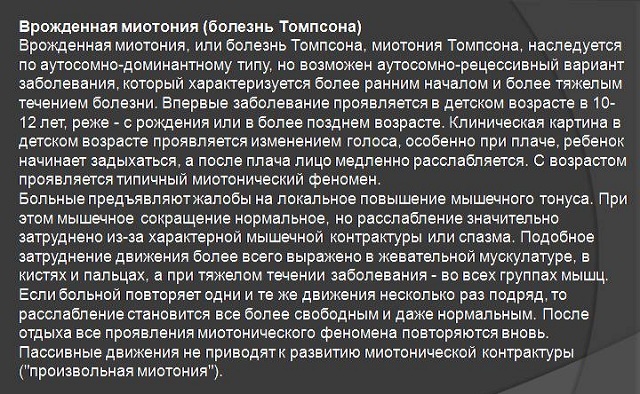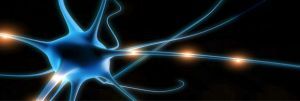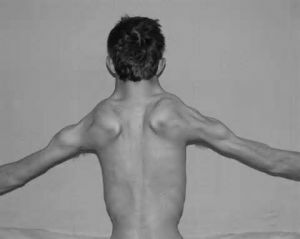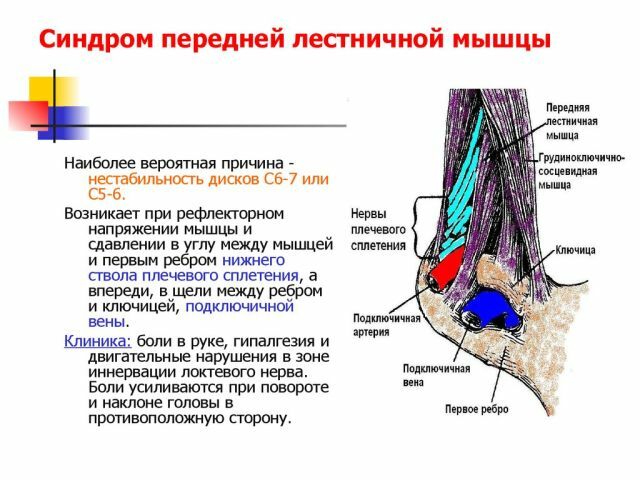 Myotonia is a hereditary disease that is characterized by injury and as a result of abnormal development of the striated musculature, which leads to uncorrelated relaxation of the muscles of the human body after their prestress.
Myotonia is a hereditary disease that is characterized by injury and as a result of abnormal development of the striated musculature, which leads to uncorrelated relaxation of the muscles of the human body after their prestress.
In addition, the disorder is accompanied by a hypertrophic change in the affected muscles. The distinguishing criterion among other similar diseases is the damage to the facial muscles, as well as the change in the tissues of the hands, which leads to a loss of sensitivity and the ability to move them.
Varieties of forms of
There are several types of myotonia, the most common forms of the disease are:
- dystrophic disease of Rossolimo-Steinert;
- paraomyotonia;
- chondrodystrophic;
- myotonia Thomsen( Thompson);
- myotonia Becker;
- is a neuromyotic form;
- congenital autosomal recessive hereditary;
- is a congenital autosomal dominant.

Etiology and pathogenesis of
Myotonia is a hereditary disease that is associated with abnormal DNA development and develops in children during the embryonic period.
The disease has a relationship with a defect in the seventh chromosome. The CLCN1 gene begins to work inappropriately and neutralizes the process of protein synthesis in ion channels of myofibril responsible for the formation and proper functioning of skeletal muscles.
As a result, a decrease in the amount of protein leads to the fact that chlorine ions cease to fall appropriately into muscle fibers. The unstable work of the gene, the lack of proper amounts of protein and the inappropriate transport of chlorine elements into the fibers create a phenomenon of excessive excitability of sarcomella, which leads to unstable bioelectric work of the latter.
Strangely enough, yet another distinctive feature of the development of the disease is the functioning of the neuron without deviations, which leads to the effect of uncontrolled muscle spasm.
This process occurs as follows, a normal nerve impulse that occurs when it comes into contact with the stimulus or is sent by the nervous system passes through the membrane of the myofibril, which reacts not in standard but several times stronger.
Therefore, the impulse sent to the muscle commands it to decrease extremely, but it does not relax due to the fact that the chlorine supply process is broken and the muscle remains tense. 
Another interesting aspect of this disease is that there is no one pulse. They arise in a bunch of several waves, which leads to paralysis of whole parts of the patient's body.
After this, a period begins when it is impossible to relax tensioned muscles. The duration of this period is different. Then follows the process in the body, which can be conditionally called compensating.
Channels that pass ions that carry missing trace elements begin to work very hard, the muscle is normalizing, but as soon as the muscles relax, and the need for transportation of all these substances in the increased volume ceases, a new failure occurs and the transportation does not end, continuing for some time.
All this in a complex destructively influences the formation of the right muscular system and leads to the fact that there is an uneven distribution of muscle tissues whose structure is damaged and incapable of normal functioning.
Thus, the causes of the disease lie in the violation of the work of the sites of the seventh gene, which consists of a huge number of different parts.
Symptomatics and diagnosis of
Detection of the disease is possible through a test called "Fist".The test is quite simple, it is necessary to suggest the patient to tightly clench the fist and hold it for some time.
 If after that the fist will be difficult to unravel or it will be necessary to apply a fairly large amount of effort, it is possible to suspect myotonia and it is necessary to conduct more in-depth studies in this direction.
If after that the fist will be difficult to unravel or it will be necessary to apply a fairly large amount of effort, it is possible to suspect myotonia and it is necessary to conduct more in-depth studies in this direction.
Muscle contraction can occur not only in the compression of the fist, but also in the tension of other muscles, for example, the jaw, with the opening of the eyes or a sharp rise from the stool.
A characteristic manifestation of the disease in any form is the modification of parts of the body. First, deformation of the hands occurs, then the lower leg, the facial muscle, change. Also, the course of the disease is associated with the occurrence of spontaneous spasms, which paralyze the patient's body.
A more accurate diagnosis is established using needle electroneuromyography, which reveals a symptom characteristic exclusively for the myotonia - myotonic discharges.
An interesting fact, if the SCN4A gene site does not work, then unlike CLCN1, the symptomatology of the disease and the parameters will be different.
The diagnosis is made at an early age, which is typical for a disease that is transmitted genetically.
Initially, the child's parents turn to the pediatrician, who should direct them to the children's neurologist. As already mentioned, before performing more complex tests and prescribing tests the neurologist will test the child with the help of the "Cam".
The next test is a muscle tapping with an ordinary neurological hammer, the alarm is the formation of a "cushion" at the point of contact of the epidermis and irritant. Also, there is a possibility that the pupil will not be able to respond properly to bright light.
Further diagnosis of the disease will be carried out using electrophysiological studies. At this stage, electroneurography and electromyography will be used.

Genetic analysis - the main method for diagnosing myotonia
The principle of these procedures is that repeated discharges of current are sent to the human body, which allows to reliably determine and reveal the systematic nature of the deviations, so that it is possible to determine what kind of myotonia will be necessary to fight.
Also applies a muscle biopsy, which allows you to determine the degree of deformation of muscle tissue and understand the causes of this phenomenon.
However, for a more accurate diagnosis it is necessary to conduct molecular genetic studies of the damaged gene number seven.
Therapy features of
Modern medicine does not have methods for restoring unhealthy gene sites. Therefore, the main task in the treatment of myotonia is slowing the progress of the disease and reducing the number of attacks in the patient.
 For this, Diphenyl, Carbamazepine, Tegretol and others are used. Prevention of disruption of the processes of ion work is achieved with the help of drug therapy, electrophoresis, galvanization of the neck.
For this, Diphenyl, Carbamazepine, Tegretol and others are used. Prevention of disruption of the processes of ion work is achieved with the help of drug therapy, electrophoresis, galvanization of the neck.
Another important nuance is the measures aimed at normalizing the amount of potassium in the human body and preventing its reduction.
In achieving this goal, diuretics are used that remove excess material from the body. The most acceptable drug is Diacarb, which has the necessary positive effect. Also, do not neglect massage and exercise therapy, which are performed to relieve muscle spasms.
Forecast is disappointing
Certainly, myotonia, a disease incurable and persists throughout the life of a person. However, earlier diagnosis and professional medical care can make the course of the disease progression benign.
In most cases, patients can lead a lifestyle that is characteristic of a healthy person. Subject to the right course of treatment, most patients remain able to work.
Of course, there is a limitation, a person who has such a serious illness can not be a policeman, a fireman or perform work related to active physical activity. However, he will be able to work in the office, perform work related to servicing the PC.
The main way to combat the disease is its early diagnosis, which can protect the child from the unpleasant consequences of the development of the disease.
It is worthwhile to understand that another preventive measure is the elimination of all movements that can lead to a recession of the disease. Various overloads, mental, emotional, stressful situations should be controlled, a sharp reaction to them will cause a new stage in the development of the disease and disastrous consequences for the human body.
Parents should understand that the disease is hereditary and may not appear in the first generation, but you should consult a genetics doctor before starting a child.



